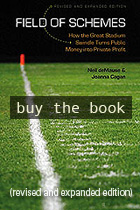This is an archived version of a Field of Schemes article. Comments on this page are closed. To find the current version of the article with updated comments, click here.
December 20, 2011
NFL establishes "G-4" stadium fund, there is much rejoicing
Just realized I never recapped last week's NFL owners meeting to formally re-establish the exhausted G-3 stadium fund, as previously pre-announced last summer. And so, without further ado:
- The new loan program — which actually will be called "G-4" — ups the maximum loan level from $150 million per team under the old plan to a maximum of $200 million under the new one. Only projects costing at least $400 million, and with a "private contribution" from the team of at least $200 million, will be eligible for the top loan level
- As under G-3, teams can repay the loan with club seat money they normally would have had to share with the league. They can now also use incremental regular ticket revenue, defined as the difference between ticket sales in the new stadium and average sales in the last three years of the old one.
- "The project must not involve any relocation of or change in an affected club's 'home territory.'" That's in keeping with the old G-3 plan's goal of aiding teams in building new stadiums in their existing hometowns (to avoid the kind of city-hopping that gave us the St. Louis Rams and Tennessee Titans). Still, it's worth noting that this means the Minnesota Vikings, for example, can access $200 million in G-4 loans for a new stadium in Minnesota, but not for one in, say, Los Angeles.
Teams looking to build new stadiums without paying for them themselves are, naturally, thrilled — since this is money that they wouldn't normally get to keep anyway, it's effectively a grant, not a loan. (Unless club seat and ticket sales come in below projections, in which case they're on the hook for the difference.) San Francisco 49ers owner Jed York tweeted that he was confident his team would be first to get a cut of the G-4 boodle, San Diego Chargers stadium czar Mark Fabiani called it "great news for the team and our fans," and Vikings stadium chieftain Lester Bagley called it "good news," though he quickly added the caveat that the Vikings still don't have a deal for the other $800 million it takes to build a stadium these days.
And that's the catch: Most of these teams were counting on NFL funds as part of their stadium deals already, so while the establishment of G-4 comes as a relief to them, it doesn't really do much to fill the funding holes that most of these teams (except for the 49ers) still have in their plans. And while it'd be nice if the teams used this free league cash to reduce their demands on taxpayers, it looks like most of them instead intend to use it to replace their own share of stadium costs.
For more on all this, the San Diego Union Tribune has helpfully posted a document containing a brief summary of NFL commissioner Roger Goodell's press conference and the actual G-4 document language. Highly recommended for anyone who finds discussion of "tranches" to be compelling reading.
The Vikings for one have been quoting $400-500 million as the "team" contribution for at least a year now. But then when that is picked apart there has always been a $200 million "loan" from the NFL making up nearly half of the money.
Which from the NFL's perspective makes sense as you should want the stronger divisions to subsidize the poorer ones in what is in effect a single business. But calling it part of the "teams" contribution seems to me a little bit disingenuous.
Posted by Joshua Northey on December 20, 2011 10:23 AMIf the NBA had a similar program ($200M is approximately 1/4 of a football stadium these days), the Sacramento Kings wouldn't be miles from their new arena dream -- they'd already have an arena funded.
If you look at how this affects the overall picture, think in terms of margins. 1/4 of an ESC sounds like a lot to me, but something like this turns a $10M loss into, at worst, a wash in many situations. No, not all situations; the Paul Brown Stadium situation is such a mess, all $200M would have done was decrease the size of their disaster.
On the other hand, maybe that would have been enough.
You're right about the overall effect this has, though; now teams will shop for a Ferrari of a building when, really, all the fans want is a Toyota.
Posted by MikeM on December 20, 2011 12:09 PMNeil,
Using your definition of incremental ticket revenue, wouldn't it make sense for a team to raise ticket prices once they are in a new stadium in order to maximize the 'differential'?
Posted by Craig R. Colgate on December 20, 2011 05:56 PMO/T: Happy Holidays, Neil.
Posted by MikeM on December 22, 2011 11:41 AM




